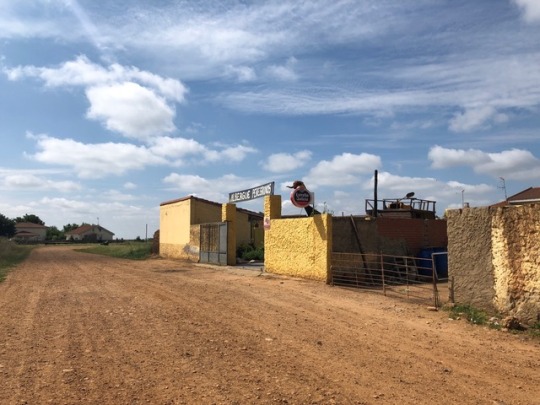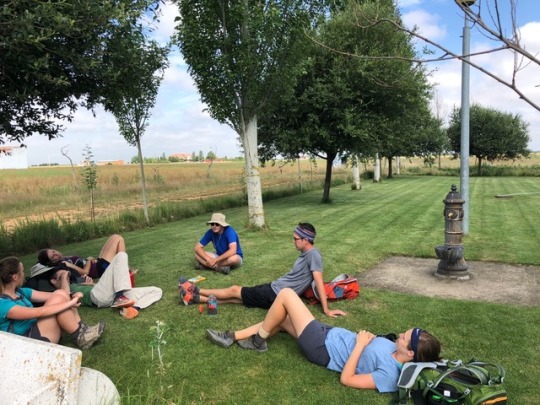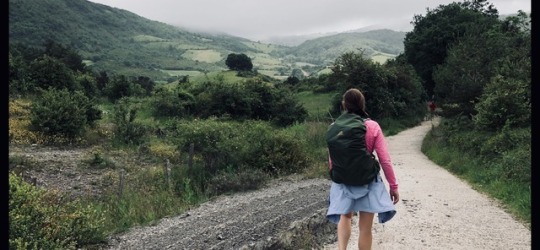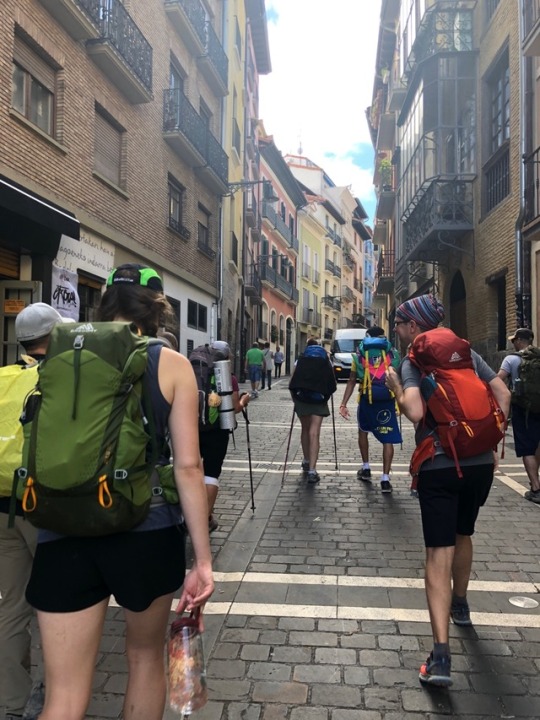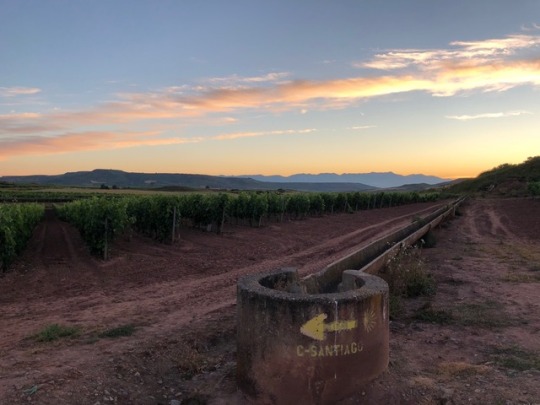Text
Villafranca de Bierzo, July 10: “Boredom.”
“Faces along the bar
Cling to their average day:
The lights must never go out,
The music must always play,
Lest we should see where we are,
Lost in a haunted wood,
Children afraid of the night
Who have never been happy or good.”
-W.H. Auden, September 1, 1939
The segment of the Camino that lies between Burgos and Leon is an interminable meseta, a flatland, one straightaway into the horizon after the other. Travelers are beginning to look a little worse for wear; sock fibers are irreversibly saturated with dust particles from the paths, so that they are impervious even to daily washing. One has the sense that backpack suspension frames have warped to the contour of the backs they hug; they seem to have become a part of their carriers. Some have even named their packs. There is weariness in this leg of the journey, as attested by the fact that many hikers with time-limitations choose to bus, according to our guide book. The scenery is drab, by contrast with the grand views and manicured vistas in earlier segments; instead we slog through industrial parks, banal suburbs, and discouragingly uninteresting natural scenes, or ones that have repeated themselves into tedium. Maybe it’s just my imagination, but the barley fields seem less golden, and more just brownish. Graffiti covers the walls of above ground cemeteries, which I wonder about - this is hard, arid soil, not like the swamps of New Orleans; what here could cause the buried to become disinterred?
Attention has the habit of being drawn to the brightest thing around. When the scenery is drab and repetitive, it turns to internal things. First, physical pains, which are not novelties here. Earlier in the trip, when we suffered our first bout of various aches, I remember Matt observing how after about 40 minutes of walking on even a shouting ankle, the pain seemed to very suddenly subside. Which of course is because of how the body assimilates sustained stimuli, like how you can’t feel the weight of your clothes, or if you’re moving at a constant speed. So the signal of pain is still sent, but is being edited out by the mind. One traveler had said, over dinner, that he ‘now knew why some people harm themselves physically; because the mind goes to the most obvious pain. And physical pain is easier to deal with than many things.’
But then, if sustained, over the course of days, over countless hills and mountains, and across an interminable drudge of meseta, as mile after equally unspectacular mile pass by, even physical pains assimilate, and deeper things might be felt. I theorize that boredom is not at all the natural reaction to uneventfulness. What one person calls ‘idleness,’ another calls ‘leisure.’ Chesterton, at least, believed that the mere fact of existence was enough to fascinate the peaceful mind ad infinitum, so that “a man sitting in a chair might suddenly understand that he was actually alive, and be happy.” Boredom, rather, is a discomfort purposefully imposed by the mind when it prefers not to allow certain thing to reach up into conscious thought.
I remember stopping at one cafe towards the beginning of the Camino. Among the bustle of other breakfasters were three Asian women sitting at a table, with perfect posture, and two of them had their eyes closed in meditation. The third was drinking coffee. When we left twenty or so minutes later, there they still sat, eyes closed, not having moved an inch.
I’ve heard meditation described as not attempting to silence the mind, but allowing thoughts to drift freely into and back out of conscious thought. Or maybe, giving the turbid waters of the mind time to still. The whole of Jungian psychotherapy is based on the healing power of the voluntary encounter of the feared thing. As I continue on my walk, I consider the likelihood that, for any individual, what is most to be feared is inside, not outside. External circumstances are sometimes very bad, of course, and stink much worse than the dumpsters of Villavante - but they are like a distracting stimulus. If conditions are sustained, we assimilate - we can assimilate even to some very extreme conditions - and then we sense a rustling in deeper bushes. “Where there is cover, we look for game.” There are many here who have clearly come to face some of those darknesses, to reach their hands into dark waters, to root around in thickets in which they fully expect to find snakes. These motivations are often unconscious; people have come just to ‘get some space,’ or ‘meet people from different walks of life.’ Some say they just wanted to ‘get away from it all.’ But why the Camino then, and not Ibiza? All those things are more easily accomplished elsewhere. The errands here are not suitable fodder for small talk. It would be easier in a party town to get lost in a crowd, and drown thoughts in loud music and liquor - or keep them drowned. On the Camino, you are bound for silence enough to hear the interior nightingales; for space enough for the wrinkled mind to unfold to near its full breadth; for tedium at times, the natural consequence of which is... cómo se dice? ‘The reemergence of sunken corpses?’ You don’t go on a five hundred mile walk to get away from something. You walk because you just don’t want to run.
0 notes
Text
Calzadilla del Hermanillos, July 3: Pilgrims, and Pilgrimage
We leave Grañon, heading away from an orange sunset, bracing ourselves to walk another 28k on a bum hip, and a swollen ankle. Little Jupiter is the only thing lit in the direction we’re headed. Four or five long strips of purple earth like jagged swollen gums all seem to be gathering around a little campfire off in the distance.
Our days have settled into a somewhat regular routine: we wake up around five, tape up our feet and leave the albergue before the sun rises. We are a few kilometers out when the sun starts to rise, around six. Walk in silence until eight, next town we see, we’ll find a cafe where Matt and Ruth order cafe Americanos, and I ask, “hay cebollas en la tortilla?” (“Are there onions in the tortilla?”) Which, there usually are, so I have an apple, or a granola bar, and we break out the guide book and decide where we want to end up that night. Sometimes we call ahead to the albergue to make sure there’s space, which, there usually is. Then we walk another fifteen or twenty kilometers, find our town, locate the albergue, check in. We shower and wash our clothes - a part of the routine we’ve come to affectionately call “afternoon chores,” which is not the highlight of the day, but there’s a little bit of urgency about it, since the clothes will dry better if they’re hanging in the sun. We’ve usually worked up an appetite, so we’ll find food somewhere, and order a few beers, then return to the albergue for a siesta. Everything closes in the afternoon anyway. We have some leisure hours, before mass at whatever local church, usually between six and eight o’clock. Then dinner, and ice cream. At ten, as we prepare for bed, the sun is still high in the sky. Small towns are quiet, and large ones, like Nájera, Logroño, and Burgos are far from it, regardless of what day of the week it is.
One afternoon, we are sitting at a small square table outside a cafe in Nájera, and the teenagers are celebrating the start of summer, playing music and jumping in the river out beyond us. One of us spots the unmistakable peregrino-uniform: sandals, shorts, synthetic workout shirt, and says, “look, there’s another pilgrim.“
A sort of incongruity suddenly dawns on me in that moment, which the topic comes up again during our walk the next day, when Ruth tells me she had been reflecting on what the word ‘Pilgrim’ means, besides the sense in which it is used here in peregrino-land: the exhausted looking tourist wearing a fanny pack that has his passport in it, along with a handful of euros that the local tortilla-y-bocadillo cafe, or sunscreen-n-chochky shop would happily separate him from, in exchange from some lightweight, “spiritual” memento and keepsake, like a Santiago-cross necklace or St. James seashell.
Under normal circumstances, the first thing that comes to my mind is like, the black and white-Puritan garb and a big triangular hat, like the people that landed in Plymouth Rock. Ruth was trying to draw the distinction between a pilgrim and a traveler. She said, “A traveler is essentially somebody who is trying to escape home, where as a pilgrim was somebody who is trying to get more in touch with his true home, which is a spiritual one. I remember,” she said, “ listening to a homily at the Basilica of Saint John Lateran, in Rome, about how no matter where you are baptized, if you are baptized into the Roman Catholic church, then this parish was, ultimately, your home parish, and the church into which you were baptized. And the most uncanny feeling came over me,” she said, “and I felt I was given this great grace. I felt more at home than I have ever felt anywhere in my entire life.”
I remember experiencing something similar, when I backpacked across Europe, and going into the cathedral in each town; though the country and its customs were all so foreign to me, the church doors were always open. And I think because of their size and grandeur, there is a huge sense of validation that comes with it, for a possibly otherwise insecure traveler. “I think a traveler is just like, ‘one who travels,’ and so a pilgrim falls into that category. But he is distinct from the ‘vacationer,’ who is also a traveler, but of the opposite orientation, since the vacationer wants an escape from his home. The business of the vacationer is temporary, whereas the business of the pilgrim is always permanent. Like the people on the Mayflower. Obviously now, it is pretty much only used in a spiritual sense.”
“And another little metaphor I was thinking about yesterday,” she went on, “are the little yellow arrows that guide you along the Camino, especially when the road splits. It’s like in life, you might have any number of divergent paths. Like I might say, ‘ look at that beautiful bridge, it’s blue, and the view is probably spectacular, I bet it leads somewhere great.’ But you only have to think about it long enough to see if there’s a yellow arrow there, pointing you down that road. And if there isn’t, then you just stay on the road you’re on.”
This is Ruth’s simple faith, and I think it’s beautiful, but I feel like - I don’t know - like God speaks to me in a whole different language. There’s a rustle of bird sounds in a tangle nearby, and rows of grape in arcs along hills on either side of us. These long straightaways, especially beside highways, can be brutal. The backs of our legs brown like marshmallows. I feel something like frustration, and, looking down at my feet, think of another pithy little synecdoche: here’s a snail moving across the Camino - just like us, and just like, ultimately, life, right? Except that his little shell is smashed and he is all but decomposed otherwise. What should’ve been a perfect Fibbonacci swirl, is shattered on the pavement, its progress interrupted, abandoned, in eternal ruin.
“What if there are five divergences, and they all have yellow arrows pointing down them?”
She just smiled, and kind of scoffed, but I meant it, a little, maybe a lot. So I continued. “Seriously, I feel like my challenge in life is more often that there are too many arrows, rather than too few.” She kind of shrugged and said something only partially serious. It’s quiet then, for a while, except for a hum from the road a bit off in the distance. The grape vines have turned back into barley on one side, and it’s all curved with the weight of grain, but all in a uniform direction, like combed hair. I want to see everything, go everywhere, meet everyone, which becomes difficult when a decision comes along, because of course, saying yes to one thing means declining the rest. How can you invest fully in any one thing when you are haunted by the absences required as sacrifice, by the unrealized potentialities left behind?
In some ways, I think it’s unsolveable, or maybe that it reaches into the area in me that I hide from, which knows the answers but doesn’t have the courage to enact them.
But so I say, “well, you might have seen a yellow arrow on the street side, on a curb, on a side wall, on a post, and when you lay down at night and close your eyes, your mind recalls all the images side by side, so that you conceptualize five different pathways, all marked with yellow arrows. But that’s not how it is in reality. When you walk the next day, you might walk past all five, one after the other.”
I kept thinking about our previous topic, and I told her about extensive conversations I’ve had with a friend of mine who has lived all over the place, and how she frequently contrasts her life with mine, at least geographically, since I’ve only lived in a region with a radius of about three miles my entire life. I know what backyards to cut through in my home town, and who coaches the little league teams, where to get a good snowball, and can contact almost everyone I know by calling loudly out the window. And she used to envy that, in a sort of way, since she had something of a fractured semblance of belonging to any one place. But then I would describe to her this strange but deep inner seemingly impacted feeling of displacement. I wanted a look at things from her side of the fence, even as she envied mine. I wanted to go wandering, like the vacationer, but I wanted to go searching for - some unknown thing. I think I have mistaken one type of travel for the other at various points in my life.
“That’s something that I’ve been thinking about, especially over the last few months,” replied Ruth, “since I’ve had sort of an itinerant life. And it’s not like I could go back to Wisconsin and it would be the same.”
None of us can go back to Eden, I think. We go on hikes at home, but they’re not pilgrimages. And they always go in a circle, and just end up in the same place they started. Here, we go out in a line, to somewhere new, somewhere we haven’t ever been before. Of course, in order to do that, you have to pack light; you have to divest, lose everything, leave everything behind. The way is narrow, and passage is mean.
“I guess that’s the point of pilgrimage, is to kind of click your heels together and say ‘no place is home, no place is home,’ and meditate on that. No place here, anyway. Any door here could be an albergue, the place you stay for the night, or for longer. But they all have yellow arrows on them. You eventually realize that you’re not there yet, even in the places you’ve become most comfortable. Or even with the people you most rely on. Not there yet.”
We reach the albergue, and soon our hands are back in tubs, scrubbing our socks, ringing them out, clipping them onto lines. Pilgrims pass in and out of the streets, purchasing supplies for tomorrow, and arranging themselves into quaint little domiciles. Priests prepare for evening mass. The sun is high on its meridian, and out in the fields, snails crawl across paths, and up tall stalks of barley, on their mysterious errand.
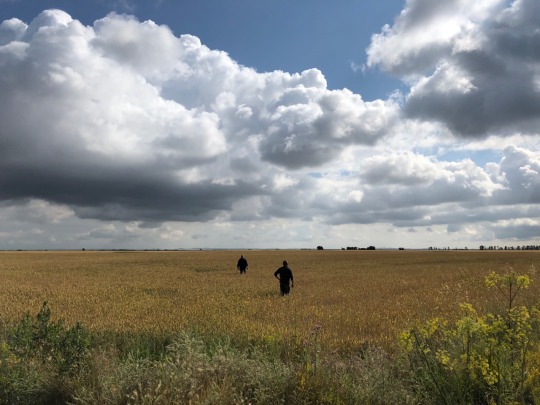
0 notes
Text
Boadilla Del Camino, June 30. “Pithy Little Anecdotes”
There is a weathered looking man, tall, with tanned, leathery-looking skin, and grey facial growth quite a bit longer than stubble. He’s seated, angled in recline; his feet are out, extended, and crossed. There are hardened callouses that look like bullet wounds at most places of contour, and most of his toenails are purple, but thick as guitar picks. He walked here, from Holland, because, “I said, if I’m going to do it, I’m going to do it right. For me, it is everything or nothing. If I skip one meter, then it all means nothing.” It makes me feel more like a tourist than I have yet on this trip. “You didn’t walk here from the US, did you?” he asks. I look down at my arms. They are starting to bronze a bit. I sigh though, and say no.
We sit on a backyard terrace at the albergue drinking what has become a habitual afternoon beer, as great nimbocumulous clouds collect and move overhead. We’ve already moved our drying laundry under the roof, so let them come. “Walking in Spain is like a dream,” he says, and he is right. His wounds he has probably collected in Belgium or France. They look like they’ve had time recently to heal. But there is more. Today’s walk has been like so many; the image I have seen in so many films, probably when a character has died, or is dreaming, and maybe I’ve seen it even in my own dreams; a long dirt and gravel path, which is washed like everything else, in the high sun overhead, overexposed. The road is lined with brush, growths with red blossoms, like drops of blood. Beyond the brush, acres of barley spread out like a blanket, golden, bent with the weight of its ripe grains, all to one side, bowing a deep, sincere bow, as to the great heavens above and its glowing chariot; a somber image, of peace, of contemplation, of death.
When a person wants to think, he prefers to walk rather than to sit still. Perhaps he seeks to ‘give to the body the meal that the soul needs’; if he wants the mind to move, putting the body in motion will help that. The mind is finicky. It goes in circles, like many hikes. But not a pilgrimage. A pilgrimage goes somewhere new. It goes out, and out, ending where it did not begin. So the Camino lends itself to this kind of thinking: life-thinking. The wide pastures and power-line-less sky provide the serene kind of backdrop devoid of much distraction that might allow even the most scatterbrained mind to focus, to collect around a thought, to sustain a struggle.
The great pitfall here, to me, is that because the Camino (Spanish for, “the way”) simplifies scenery for most, easy metaphors for life become a distraction. The mind, which has come here searching for answers of some sort finds itself falling too easily into ready-made grooves, pretending it is satisfied on low hanging fruit, and buying souvenirs to remember them by. “Life is like a long walk; you meet people along the way, and some of them help you.” Or like, you see ants walking in a row laterally across your path carrying bits of grain, and you think, “We hikers are like that, moving in a long row, trying to carry something valuable and nourishing, but immaterial.” In my more jaded Holden Caulfield-ish moments, I feel that these “revelations” aren’t much more than obvious tautologies; but they do reveal an appetite of the mind, at least of the ones on this road, calling out like an open-mouthed birdling for something to close upon and digest. The most commonly asked question, aside of basic biographical inquiries, is some version of, “Why did you decide to hike the Camino?” It almost betrays a secret freneticism, as though we are all pretending to be curious about one another’s raison-de-être, reason for being, or at least for being here, but really only looking to discover our own. Or at least one that seems worthwhile. And most peregrinos have a ready-made answer, which sounds well-rehearsed. You can imagine they have told it to 20 other people they have met here, and probably many others before they left. And sometimes, I think they believe the reason they give. Oftentimes, I do not believe them. I have given several different answers already, and I’m not sure if I believe any of them myself, fully. At least, none of them seem satisfying. I don’t really remember “deciding” to hike the Camino anyway. But what does it matter? Here I am.

0 notes
Text
From Villafranca: “Preamble: An Advanced Warning for the Quick of Thumb”
“There is a remarkable picture called “Contemplation.” It shows a forest in winter and on a roadway through the forest, in absolute solitude, stands a peasant in a torn kaftan and bark shoes. He stands, as it were, lost in thought. Yet he is not thinking: he is “contemplating.” If anyone touched him he would start and look bewildered. It’s true he would come to himself immediately; but if he were asked what he had been thinking about, he would remember nothing. Yet probably he has hidden within himself, the impression which dominated him during the period of contemplation. Those impressions are dear to him and he probably hoards them imperceptibly, and even unconsciously. How and why, of course, he does not know. He may suddenly, after hoarding impressions for many years, abandon everything and go off to Jerusalem on a pilgrimage. Or he may suddenly set fire to his native village. Or he may do both.” -Dostoyevsky (The Brothers Karamazov) Why one decides to go on a pilgrimage, I am not so sure. One can hardly ever be certain of one’s own real motives. But Dostoyevsky’s explanation is, I think, as likely as any: because he didn’t want to burn down his home village. But here we are, already ten days from St. Jean Pied de Port, our point of departure, more than a hundred kilometers having passed underneath our feet; our ankles and hips have borne much of the impact, and they tell each of the three of us the story of the journey thus far, at various volumes. But among fractured memories, impressions already accumulate; there is already this strange distance, besides the geographical, between now and where we were just a few days ago: the crowds in Logroño, or the plaza in Los Arcos, the monastery in Estella. They feel like ancient history, or like, something that happened in a snow globe. And what about the impressions that preceded our departure altogether? People ask us why we came, and I often say, “because Ruth asked if I wanted to go.” But that’s only a time-saving response. Subtle things have momentous consequences sometimes. Like, what’s the difference between traveling and taking a pilgrimage? Or the difference between ‘thinking’ and ‘contemplating’? What is an “impression”? An impression is a sketch, A very low resolution image, a general sense which guides the emotions, especially with regard to collections of things and events which are so numerous that they cannot all be thought of, consciously, at once. Formulating them is largely the business of the unconscious. Ruth has been working on this party trick where, she says, a man was given 50 random objects, and then asked, “ what was the 13th object?“ and he could recite all of them back, with perfect accuracy. Ruth has been practicing the trick of associative memory, with some of the spare time we happened to have on the trail (she is up to 20), but everyone knows under regular circumstances, you can’t specifically think of 50 things at the same time. So, if you experienced 50 days somewhere, say hiking the Camino, your mind can’t simultaneously think of each of the 50 days individually, so it formulates an impression of the ‘overall experience,’ as though it was one thing, and you say “the Camino was challenging but beautiful. I learned a lot about myself, and also got to meet some great people along the way.” In that, you have reduced 50 days of probably thousands of individual events into just four items, which can all be thought of simultaneously. People often reduce things even more than this, so that you ask them, “ did you have a good experience in college?“ And they will say, “yeah, college was super fun.” They have forgotten about individual moments, many horrible ones; every time they cried their eyes out during that chapter of life, or were broken-hearted, or injured, or struggled to pass a test, or stayed up all night with a friend who was depressed, and having a panic attack. They have chosen, for whatever reason, to pull over everything difficult or complex or not memorable, with a curtain of one solid color, in this example, perriwinkle blue. It is futile to warn against formulating impressions, though there are a very great many dangers there, which it is perhaps well to be aware of. We cannot really beware them, but we might be more aware of them. It appears as though what the mind is doing is something like paint mixing, where any emotional output is registered as some kind of color, perhaps anger is red, repulsion is green, pleasure blue, and so on. And when asked to recall a segment of its history, it produces a blend. But how accurate is that blend when compared to the reality? Is the unconscious mind a reliable tool, or does it distort the truth in some way, and for some hidden purpose? And how does one measure the accuracy? The scientific method has no jurisdiction here, in the world of emotions. We know that the mind will erase, and rewrite, and that there is reconstruction going on at almost every moment. Does the mind even present us with an accurate portrait of the day when we close our eyes to go to sleep at night? Does it remember all the hills and valleys in glorious sunshine, every stalk of barley, and each red flower kenspeckled along the fringe? Did it remember the depth of the horror in the waste of Nájera? The drooped faces of the teenagers being carried off the streets by their friends, the waste along the river, and was each shard of broken glass taken into account? Did it correctly assess the depth of the insult to Saint John the Baptist, the great ascetic, in whose name a rakish feast was held? Did it remember the tweet of each bird, the creaking of every cricket in the late evening, the shape of each cirrus cloud disappearing along the horizon? Did it hear each lyric to every song, and did it remember even its own dreams from the night before? Or rather, was the impression formed after a process of less than random selection? Does it choose which events to exaggerate, which to suppress, which to put in the basket, and which to leave behind? And who is responsible for making these selections? Someone other than yourself? Or can we rightly say it was the ‘will,’ there quietly choosing how your life will seem to you, even before you have lived it? I’ve gone far beyond the scope and breadth of my knowledge even in asking these questions, but all that’s to say that much of what I relate will be an impression, or about one, and they are only abbreviations of real things. First impression of the Camino: it is long, and therefore there is the time and space for the long thought, rather than the short cut. For detail and accuracy over expedience. So advanced apologies to those accustomed to snippets and slogans which are brief enough not to slow your Instagram-scroll. This is a space for solitude, for the hard-earned truths that come with alone-ness. Maybe it should be considered “anti-social media.” For things in reality cannot be reduced to less than they are themselves; there is no way to relate splendor in a way that is less than splendid, or pain in a way that does not hurt. So carry in the back of your mind this kind of skepticism as you read, and be aware of your own mind, as you think of one and a half million individual steps as though it were one walk.
0 notes
